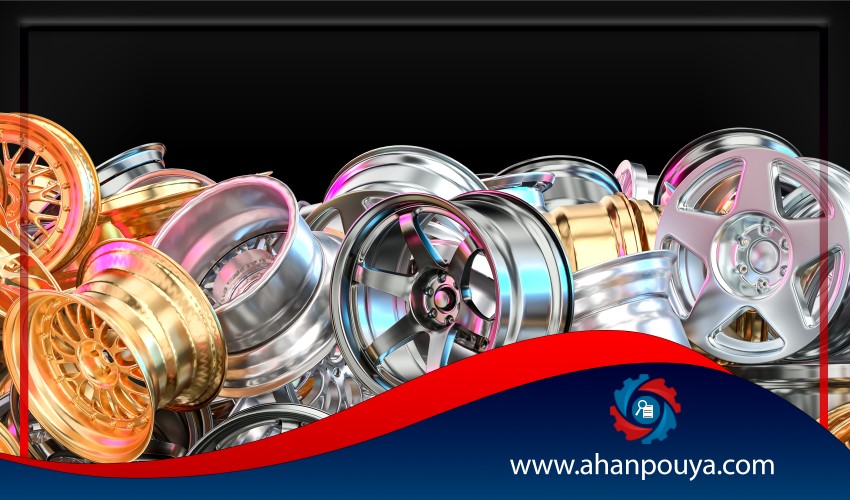
Aluminium is one of the most popular and most popular metals in various industries . Due to its light weight, high strength and flexibility, as well as corrosion resistance and other positive properties, aluminum has found a special place in important industries such as aerospace and automotive. engineers are also used in scientific and chemical solutions to improve their properties . One of these methods is called anodizing, during which the corrosion resistance of aluminum becomes much greater and better.
Most of the metals we deal with tend to combine with ambient oxygen and oxidize When the surface layer of metal oxidizes A stable thin layer is produced on it Which increases the corrosion resistance of the metal. Aluminum is also one of the metals on which this metal oxide is formed. But this layer of metal oxide is very thin And it can not protect the inner parts of the metal from corrosion for a long time . Aluminum is used in many industries due to its lightness, strength, elasticity, electrical and thermal conductivity, malleability, flexibility, light reflection, non-magnetism, non-sparking, ductility and high weldability. Hence it must be sufficiently resistant to corrosion and erosion . To solve the problem of low thickness of aluminum oxide layer, engineers use electrochemical methods . Therefore, the process by which an aluminum oxide layer grows and thickens on an aluminum surface under controlled conditions is called anodizing. This process helps the aluminum oxide layer to grow several thousand times its natural thickness, and the aluminum sheet becomes much more resistant to corrosion than normal.
The process of anodizing aluminum is done in such a way that the workpiece or the same aluminum is placed in an electrolyte environment such as oxalic acid or sulfuric acid as an anode . Then another suitable material such as stainless steel, graphite, lead or aluminum itself is considered as the cathode. An electric current is then passed through the electrolyte material, and due to the electric current, chemical actions and reactions take place on the surface of the aluminum, creating a thick layer of aluminum oxide. It should be noted that when a layer of aluminum oxide is formed, a layer of high density and very high porosity is formed on it. The porous layer is capable of absorbing dust, corrosive substances, moisture, etc. This material penetrates the aluminum oxide layer for a long time and causes it to corrode . Therefore, after performing the anodizing operation, the work surface must be covered with a special paint to prevent corrosive particles from entering the porous layer.
Aluminum is anodized during the steps and payments, which we will briefly introduce in the following. Some steps are related to before the anodizing operation and some steps are related to after the process.
At this stage, the desired part is first changed mechanically as desired . The reason that mechanical polishing is done before anodizing is that the aluminum oxide layer is not damaged or destroyed by impact or hammering.
Here it is necessary to clean and degrease the part before anodizing, which is possible with the help of solvents and alkaline solutions. If the workpiece or aluminum surface is not well cleaned and aluminum oxide forms on the dirt, the metal will corrode very quickly and the anodizing operation will be useless.
This step is also very important before anodizing. The soot formed on the aluminum surface is well removed by nitric acid to perform the anodizing process with higher quality and more accurate.
After cleaning and sooting the aluminum metal surface, it should be properly polished and polished by electrochemical methods. The more the metal surface is in contact with air and electrolyte, the more the aluminum oxide layer forms on it and does not become uneven.
Execution of this step depends on performing the previous steps . Without them, the anodizing operation will be ineffective and will not prevent corrosion . It may even accelerate metal corrosion due to the trapping of corrosive substances in its labia. At this stage, as mentioned before, the workpiece is anodized in the electrolyte by electric force and a very thick layer of aluminum oxide is made on it, which makes the aluminum resistant to corrosion many times over.
As mentioned before, the anodized layer of aluminum oxide should be covered with layers of paint as soon as possible. There are usually two ways to do this, namely painting anodized aluminum.
At this stage, it is necessary to seal the workpiece after painting so that the paint stays in place and any possibility of corrosion is eliminated. this method is one of the strategies to fill the metal oxide . There are several methods for sealing. But the most common and most common of them is the use of 98 degrees boiling water . The anodized aluminum sheets are soaked in boiling water for 20 to 50 minutes to fill their cavities with hydrated aluminum oxide. In addition to boiling water, metal salt solutions are also used. The metal salt used in this case can be one of the following :
Copper sulfate or chromium sulfate solution, cobalt solution, sodium silicate and acetic acid solution, lead acetate solution in acetic acid or formic acid, zinc chloride solution, calcium sulfate or sodium chloride, sodium sulfate. It should be noted that nickel is used as nickel acetate and cobalt and boric acid for sealing aluminum.
At the end of the anodizing operation and the subsequent steps, the workpiece should be electrochemically dried quickly. This is done at low temperatures and with great care To prevent any cracking of the paint and the layer of aluminum oxide . Aluminum is now ready to be used in any weather conditions because it is not strong enough and does not corrode.

Ahan Pouya with more than a decade of best-selling experience, adheres to professional and ethical principles in the field of selling and buying at inside and outside the borders of Iran, helping you in the steel industry.